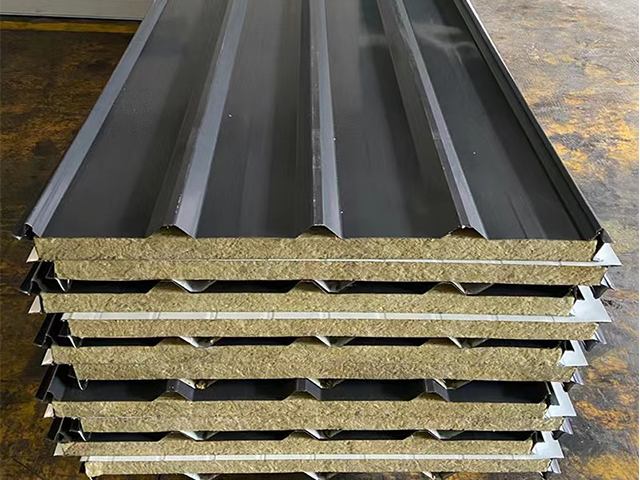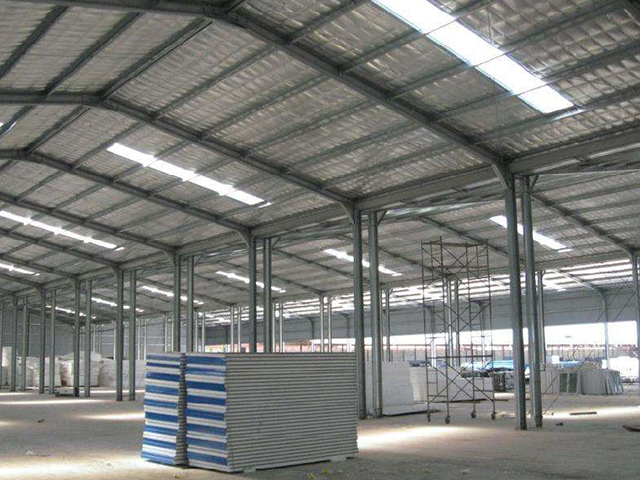ໃນຊ่วງຫຼາຍປີມານີ້, ວິສະວະກອນ ແລະ ນັກຜັງເມືອງທົ່ວໂລກໄດ້ຫັນມາໃຊ້ເຕັກນິກການກໍ່ສ້າງທີ່ປະຢັດພະລັງງານເພີ່ມຂື້ນ. ພາຍໃນການປະດິດສ້າງເຫຼົ່ານີ້, ແຜ່ນຊັ້ນກາງ (sandwich panels) ຖືກເນັ້ນເຖິງຄວາມສາມາດໃນການໃຫ້ຄວາມຮ້ອນທີ່ດີ ແລະ ຄວາມເຂັ້ມແຂງທາງດ້ານໂຄງສ້າງ. ບົດຄວາມນີ້ມີຈຸດປະສົງເພື່ອຄົ້ນຫາເບິ່ງວ່າເປັນຫຍັງແຜ່ນຊັ້ນກາງຈຶ່ງມີຄວາມສຳຄັນຫຼາຍໃນການກໍ່ສ້າງສີຂຽວໃນປັດຈຸບັນ, ພ້ອມທັງພິຈາລະນາເບິ່ງວ່າປັດໃຈໃດແດ່ເຮັດໃຫ້ມັນເປັນປະໂຫຍດ, ວິທີການນຳໃຊ້ໃນໂຄງການຕົວຈິງ, ແລະ ທິດທາງໃນອະນາຄົດຂອງເຕັກໂນໂລຊີດ້ານນີ້ຈະເປັນແນວໃດຕໍ່ການພັດທະນາ ແລະ ການນຳໃຊ້.
ຄົ້ນຫາແຜນສ້າງ
ແຜ່ນ sandwich ມີຊັ້ນນອກສອງຊັ້ນ ດ້ວຍວັດສະດຸພາຍໃນທີ່ສາມາດເປັນ polystyrene, polyurethane ຫຼື ບາງຄັ້ງກໍ່ເປັນຜ້າເສັ້ນໄຍແຮ່. ສິ່ງທີ່ເຮັດໃຫ້ມັນພິເສດແມ່ນຄວາມສາມາດໃນການໃຫ້ຄວາມຮ້ອນທີ່ດີ ພ້ອມທັງຄວາມເຂັ້ມແຂງຂອງໂຄງສ້າງທີ່ດີເດີ້ນ. ແຜ່ນເອງບໍ່ໜັກເລີຍ ສະນັ້ນການຂົນສົ່ງຈຶ່ງງ່າຍຂຶ້ນຫຼາຍ. ພວກຊ່າງຮັບເຫຼົ່ານີ້ມັກໃຊ້ໃນການຕິດຕັ້ງສ່ວນຕ່າງໆຂອງອາຄານເຊັ່ນ: ພື້ນ, ຫຼັງຄາ ແລະ ຝາ. ທັງເຮືອນຢູ່ອາໄສ ແລະ ອາຄານທາງການຄ້າໃນເຂດເມືອງກໍ່ໄດ້ຮັບຜົນປະໂຫຍດຈາກການຕິດຕັ້ງນີ້. ຄ່າໃຊ້ຈ່າຍໃນການແຮງງານຫຼຸດລົງຢ່າງຫຼວງຫຼາຍ ເນື່ອງຈາກການຕິດຕັ້ງໃຊ້ເວລາໜ້ອຍກ່ວາວິທີການດັ້ງເດີມ.
ຄວາມສຳຄັນຂອງຄວາມມື້ງມື້ງເຄື່ອງມື
ແຜ່ນ sandwich ສາມາດນຳເອົາບາງສິ່ງທີ່ພິເສດມາສູ່ໂຕະ ເມື່ອປຽບທຽບກັບແຜ່ນສ້າງສັນທົ່ວໄປ ໂດຍສະເພາະໃນການປະຢັດພະລັງງານ. ສິ່ງທີ່ເຮັດໃຫ້ມັນແຕກຕ່າງອອກມາແມ່ນການຫຼຸດຜ່ອນການສູນເສຍຄວາມຮ້ອນ. ນັ້ນໝາຍຄວາມວ່າອາຄານຈະຮັກສາຄວາມອົບອຸ່ນໄດ້ດີຂຶ້ນໃນລະດູໜາວໂດຍບໍ່ຕ້ອງອີງໃສ່ເຄື່ອງເຮັດຄວາມຮ້ອນຫຼາຍເທົ່າໃດ. ຜົນໄດ້ຮັບແມ່ນຄ່າໃຊ້ຈ່າຍດ້ານພະລັງງານທີ່ຫຼຸດລົງໃນແຕ່ລະເດືອນ. ນອກຈາກນັ້ນ, ການໃຊ້ເຄື່ອງເຮັດຄວາມຮ້ອນໜ້ອຍລົງຍັງໝາຍເຖິງການປ່ອຍອາຍພິດຄາບອນທີ່ໜ້ອຍລົງໂດຍລວມ, ສິ່ງທີ່ເຂົ້າກັນໄດ້ດີກັບເປົ້າໝາຍດ້ານສິ່ງແວດລ້ອມຂອງຫຼາຍໆປະເທດ. ແລະນີ້ແມ່ນຂໍ້ດີອີກອັນໜຶ່ງທີ່ຄວນກ່າວເຖິງ: ວັດຖຸດິບຈຳນວນຫຼວງຫຼາຍທີ່ໃຊ້ໃນການຜະລິດແຜ່ນເຫຼົ່ານີ້ສາມາດນຳມາຮີໄຊຄືນໄດ້ຫຼາຍຄັ້ງ. ສິ່ງນີ້ຊ່ວຍໃຫ້ພວກເຮົາເຂົ້າໃກ້ເຖິງເສດຖະກິດແບບວົງຈອນ (circular economy) ທີ່ທຸກຄົນເວົ້າເຖິງໃນປັດຈຸບັນ ໃນຂະນະທີ່ຍັງເປັນມິດກັບສິ່ງແວດລ້ອມ.
ການໃຊ້ງານໃນໂຄງການສ້າງປັจຈຸບັນ
ໃນມື້ນີ້, ແຜ່ນ sandwich ສາມາດພົບເຫັນໄດ້ທົ່ວທຸກແຫ່ງໃນໂລກກໍ່ສ້າງ. ສໍາລັບການຕັ້ງຄ່າອຸດສາຫະກໍາເຊັ່ນ: ສາງ ແລະ ໂຮງງານ, ແຜ່ນເຫຼົ່ານີ້ເຮັດວຽກໄດ້ດີເນື່ອງຈາກຄຸນນະພາບການສ້າງທີ່ແຂງແຮງ ແລະ ຄຸນສົມບັດກັນຄວາມຮ້ອນ/ຄວາມເຢັນທີ່ດີ. ໃນກໍລະນີຂອງບ້ານເຮືອນທີ່ຖືກອອກແບບໃຫ້ປະຢັດພະລັງງານ, ແຜ່ນ sandwich ຊ່ວຍຮັກສາສະພາບພາຍໃນໃຫ້ສະດວກສະບາຍເຖິງແມ່ນວ່າອຸນຫະພູມພາຍນອກຈະປ່ຽນແປງຢ່າງໄວວາຈາກຄວາມເຢັນຈົນເຖິງຄວາມຮ້ອນຈັດໂດຍບໍ່ຕ້ອງກິນໄຟຟ້າຫຼາຍ. ພວກເຮົາຍັງເຫັນໂຮງຮຽນ ແລະ ໂຮງໝໍນໍາໃຊ້ແຜ່ນເຫຼົ່ານີ້ເພີ່ມຂື້ນໃນຊ່ວງເວລາບໍ່ດົນມານີ້. ສະຖາບັນເຫຼົ່ານີ້ມັກຈະດໍາເນີນງານດ້ວຍງົບປະມານທີ່ຈໍາກັດ ແລະ ພ້ອມທັງຕ້ອງການຫຼຸດຜ່ອນຜົນກະທົບຕໍ່ສິ່ງແວດລ້ອມໃນເວລາດຽວກັນ. ແຜ່ນດັ່ງກ່າວສາມາດຕອບສະໜອງຄວາມຕ້ອງການທັງສອງຢ່າງນັ້ນໄດ້ດີ.
ການຂາຍນິວ໊ານສູໆໃນແຜນສະແດງ
ການພັດທະນາໃນເຕັກໂນໂລຊີແຜ່ນຊັ້ນກາງໃນຊ່ວງເວລາຫຼ້າມານີ້ ໄດ້ໃສ່ໃຈໃນການອອກແບບໂຄງສ້າງຊັ້ນກາງໃໝ່ເພື່ອປັບປຸງຄຸນສົມບັດກັນຄວາມຮ້ອນໂດຍບໍ່ຕ້ອງເພີ່ມນ້ຳໜັກ. ຜູ້ຜະລິດກຳລັງທົດລອງໃຊ້ວັດສະດຸຕ່າງໆເຊັ່ນ: ວັດສະດຸປະສົມອີໂຣເຈນ (aerogel composites) ແລະ ລວງລວຍຮັງຜຶ້ງ (honeycomb patterns) ທີ່ສາມາດຮັກສາປະສິດທິພາບດ້ານຄວາມຮ້ອນໄວ້ໄດ້ໃນຂະນະທີ່ຫຼຸດການໃຊ້ວັດສະດຸລົງ. ໃນຂະນະດຽວກັນ, ມີຄວາມກົດດັນທີ່ເພີ່ມຂື້ນໃນທົ່ວອຸດສະຫະກຳໃນການຮັບເອົາຂະບວນການຜະລິດທີ່ເປັນມິດຕໍ່ສິ່ງແວດລ້ອມຫຼາຍຂື້ນ. ບໍລິສັດຈຳນວນຫຼາຍກຳລັງລົງທຶນໃນລະບົບຮີໄຊເຄີນ (closed-loop recycling systems) ແລະ ວິທີການແຫ້ງຕົວທີ່ປ່ອຍອາຍເສຍຕ່ຳເພື່ອເປັນສ່ວນໜຶ່ງຂອງຄວາມພະຍາຍາມດ້ານຄວາມຍືນຍົງຂອງພວກເຂົາເຈົ້າ. ໃນຂະນະດຽວກັນ, ການປະສົມປະສານເຕັກໂນໂລຊີອັດສະລິຍ (smart tech) ກຳລັງປ່ຽນແປງວິທີການດຳເນີນງານຂອງອາຄານໃນແຕ່ລະມື້. ລະບົບຕິດຕາມກວດກາພະລັງງານທີ່ເຊື່ອມຕໍ່ກັບຫົວໜ່ວຍຄວບຄຸມສູນກາງ ຊ່ວຍໃຫ້ຜູ້ຈັດການສະຖານທີ່ສາມາດຕິດຕາມການໃຊ້ພະລັງງານໃນເວລາຈິງ, ສາມາດຄົ້ນຫາຈຸດບໍ່ມີປະສິດທິພາບໄດ້ຢ່າງໄວວາ ແລະ ປັບປຸງການດຳເນີນງານໄລຍະໄກ. ເຄື່ອງມືດິຈິຕອນເຫຼົ່ານີ້ບໍ່ພຽງແຕ່ຊ່ວຍປະຢັດເງິນເທົ່ານັ້ນ ແຕ່ຍັງຫຼຸດຄວາມຕ້ອງການໃນການບຳລຸງຮັກສາລົງຢ່າງຫຼວງຫຼາຍໃນໄລຍະຍາວຂອງອາຄານທາງພາສະດາໄດ້.
ຄຳສິ້ນສຸດ: ການເຂົ້າຫາທີ່ຢູ່
ແຜ່ນຊັ້ນກາງ (Sandwich panels) ກຳລັງມີຄວາມສຳຄັນເພີ້ມຂື້ນໃນຂະແໜງການກໍ່ສ້າງ ເນື່ອງຈາກພວກມັນສາມາດແກ້ໄຂບັນຫາທີ່ແທ້ຈິງໃນການປະຢັດພະລັງງານໃນອາຄານ. ດ້ວຍເຕັກນິກການຜະລິດທີ່ດີຂື້ນອອກມາຕະຫຼອດເວລາ ແລະ ມາດຕະຖານການກໍ່ສ້າງສີຂຽວທີ່ເຂັ້ມງວດຂື້ນໃນທົ່ວອຸດສະຫະກຳ, ພວກເຮົາອາດຈະໄດ້ເຫັນໂຄງການຕ່າງໆນຳໃຊ້ວັດສະດຸປະສົມເຫຼົ່ານີ້ຫຼາຍຂື້ນໃນໄວໆນີ້. ຂະແໜງການກໍ່ສ້າງຈຳເປັນຕ້ອງປັບຕົວເຂົ້າກັບຄວາມຕ້ອງການໃໝ່ຂອງສັງຄົມ ຖ້າຕ້ອງການມີສ່ວນຮ່ວມໃນການບັນລຸເປົ້າໝາຍດ້ານຄວາມຍືນຍົງຢ່າງແທ້ຈິງ. ນັກຜັງເມືອງ ແລະ ນັກພັດທະນາທີ່ຕ້ອງການໃຫ້ອາຄານຂອງເຂົາເຈົ້າເຂົ້າກັບຄວາມຄາດຫວັງດ້ານສິ່ງແວດລ້ອມໃນປັດຈຸບັນ ຄວນພິຈາລະນາການນຳໃຊ້ແຜ່ນຊັ້ນກາງໃນໂຄງການອອກແບບຕໍ່ໄປຂອງເຂົາເຈົ້າ. ວັດສະດຸເຫຼົ່ານີ້ສະເໜີວິທີແກ້ໄຂທີ່ເປັນໄປໄດ້ໃນຂະນະທີ່ຍັງຮັກສາຄວາມເຂັ້ມແຂງຂອງສະຖານະພາບ ແລະ ຄວາມງາມທາງດ້ານທັດສະນະໄວ້ໄດ້.






